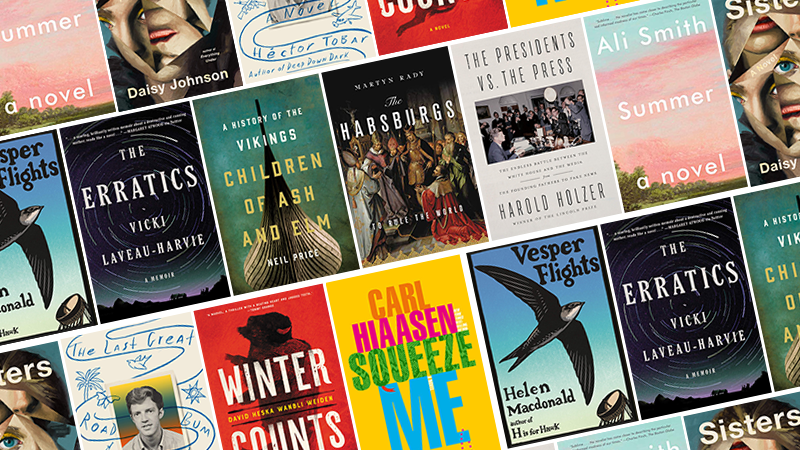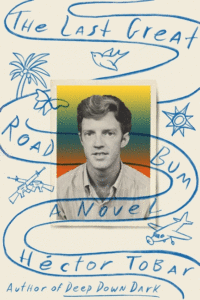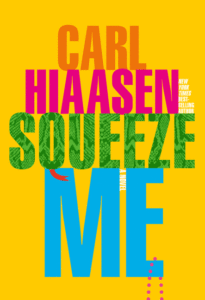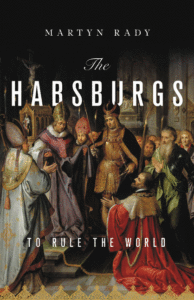
Ali Smith’s Summer, Helen Macdonald’s Vesper Flights, Daisy Johnson’s Sisters, and Carl Hiaasen’s Squeeze Me all feature among the Best Reviewed Books of the Week.
1. Summer by Ali Smith
14 Rave • 3 Positive • 1 Mixed
“The project has been an attempt to narrow the gap not only between a novel’s conception and its publication, but between art and the reality it consumes in order to produce itself … Smith’s dazzling experiment in simultaneity has pointedly thumbed its nose at rules of thumb. The result is indeed a maestra’s portrait of her age, a project at once staggeringly ambitious and entirely of a piece with a quarter-century body of work that teases so delightfully along the limits of EM Forster’s question: ‘What does a novel do?’ … How fitting that this novel should narrate for you how you feel about reading it at the very moment when you feel it, text pressing so closely against life it’s as if we are being challenged to spot the difference … But Smith’s experimentation always works in the service of good old-fashioned storytelling rather than at its expense, making it both wildly innovative and reassuringly familiar at the same time … Each novel has been part of a larger jigsaw puzzle that may now finally be assembled. Each one has also been its own collage of ideas and stories, an exercise in artful juxtaposition and exuberant ekphrasis … this novel is a remarkable and clear-sighted resolution of Smith’s project, which has felt all along as if it wants to nudge us towards hope, towards the idea that if we want to reverse the irreversible flow of history, we have to look to what the novel can do.”
–Sara Collins (The Guardian)
Read an excerpt from Summer here
2. Sisters by Daisy Johnson
9 Rave • 3 Positive
“Before too long, the novel is exhibiting the vivid unreliability of a fever dream … It’s a Gothic setup, a clutch of damaged individuals stuck in an isolated ruin, and Johnson’s bold and impressionistic writing locates the story on the boundary between fable and horror … the narrative keeps circling back to past events, building up a powerful atmosphere of doom and dread in a manner that occasionally feels a little overwrought—as if nothing bad has been left unimagined … a gripping ordeal, a relentlessly macabre account of grief and guilt, identity and codependency, teenage girls and their mothers. Crammed with disturbing images and powered by a dare-to-look-away velocity, it reminded me, in its general refusal to play nice, of early Ian McEwan.”
–Harriet Lane (The New York Times Book Review)

3. The Last Great Road Bum by Héctor Tobar
3 Rave • 4 Positive
“The book challenges Sanderson’s archetypal wanderer qualities—his white maleness, his writerly aspirations, his roving voyeurism—not by treating him as the husk of a bygone era, but by cheekily interpolating commentary in his life story … a very different kind of road narrative … The setup allows Tobar to act like a master puppeteer and stage moments of dialogue, ranging from friendly ribbing to razor-sharp criticisms. He uses these layered voices to air authorial concerns over dated conventions of the road novel (valorized masculinity, disaster or colonial tourism) … striking to read, and a reminder that The Last Great Road Bum aims to straddle two eras of the road novel: the swashbuckling freedom fantasies of earlier decades and more recent explorations that have, in part, questioned those very freedoms and their preconditions … In dialoguing with his central character, Tobar cleverly makes narrative space for these complexities. The protagonist’s commentary in the footnotes is Tobar’s main avenue for dramatizing the genre’s growing pains. Tobar takes care to chart Sanderson’s incremental political awakening to show that life on the road need not be frivolous; it can be instructive too.”
–Connor Goodwin (The Atlantic)
Read Héctor Tobar on five iconic literary road trips here
4. Winter Counts by David Heska Wanbli Weiden
2 Rave • 5 Positive
“… hard-boiled … Wholly satisfying, the novel builds to a violent, action-packed denouement, leaving space for a sequel … However, in its adoption of hard-boiled tropes, the novel doesn’t also assume the cynical attitudes of Mike Hammer or Sam Spade or sink into nihilism. Rather, it juxtaposes these tropes against the heartfelt story of a wounded mixed-race man coming into his Native identity … a riveting yet soulful reimagining of hard-boiled crime fiction for an era in which systemic rot seems to be routinely uncovered.”
–Anita Felicelli (The San Francisco Chronicle)

5. Squeeze Me by Carl Hiaasen
3 Rave • 3 Positive
“… by the evidence of the scabrous and unrelentingly hilarious Squeeze Me, the Trump era is truly Carl Hiaasen’s moment … One unnerving aspect of Squeeze Me is that it’s set in post-pandemic Palm Beach and Trump is still president. It will be useful for any pro-Biden readers to view this not as pessimism on Hiaasen’s part but simply as some additional deeply mordant humor. Just dive in and have a wonderful time … Hiaasen can always be relied on to give readers a likable, decent-hearted, beset young female protagonist to fight for justice, and Angie Armstrong is great fun to follow around … Hiaasen’s narrative wanders around a bit randomly, but with all the lovingly biting detail there isn’t a page here that flags. Even the Palm Beach hi-so names are choice, like the section in Gatsby where the long list of his party guests is so funny and revealing.”
–Richard Lipez (The Washington Post)
Read an interview with Carl Hiaasen here
**
1. Vesper Flights by Helen Macdonald
11 Rave • 1 Positive • 1 Mixed
“…dazzling … Embarking on her own vesper flights but with her eyes trained on animals, Ms. Macdonald reminds us how marvelously unfamiliar much of the nonhuman world remains to us, even as we continue to diminish it … She is in awe of the ‘invisible fungal networks that weave each forest into a symbiotic community, a place full of life hidden from our own’ … The essays in Vesper Flights give us the literary equivalent of such a resilient network, which is why I would recommend reading them in sequence: Connected by invisible threads, they gradually enmesh the reader in a universe of limitless potentiality, where a livable future suddenly becomes imaginable again. Acknowledging that nature exists everywhere, not only in places where humans don’t live, means that there are things, big and small, we can and must do: design houses so that they offer space where swifts may nest; switch off the lights in our big cities at night to keep migrating birds from getting confused; demand that a beautiful meadow, home to multiple forms of life, be made part of that new housing development instead of being flattened by asphalt.
–Christoph Irmscher (The Wall Street Journal)
Read Helen Macdonald on Sherlock Holmes, Ursula Le Guin, and hating On the Road here
2. The Erratics: A Memoir by Vicki Laveau-Harvie
3 Rave • 5 Positive
“As sinister as this sounds, Laveau-Harvie tells the story with laugh-out-loud humor, and tremendous heart and insight. She has a poet’s gift for language, a playwright’s sense of drama and a stand-up comic’s talent for timing. But perhaps most remarkable is the generosity of spirit with which she writes about family trauma … despite everything, Laveau-Harvie does not take herself too seriously, and by holding the reins of her story lightly, she gives us the ride of our lives. The book flows with kinetic energy, wit and wisdom. Upon reaching the last page, I found myself turning to the beginning and starting again, not wanting it to end.”
–Helen Fremont (The New York Times Book Review)
3. Children of Ash and Elm: A History of the Vikings by Neil Price
4 Rave • 2 Positive
“It is perhaps significant that, as a British expert on Viking Age Scandinavia and therefore something of an outsider, [Price] crosses both national and linguistic borders and the boundaries of academic disciplines, bringing together new evidence and recent international scholarship to show how the Scandinavians of the Viking Age came to ‘bend the arc of history.’ His clear, engaging style introduces us to the Scandinavian communities of the eighth and ninth centuries, centered around the farmstead, before catapulting us overseas and outward into an expanding world where raiding and trading quickly boosted the wealth of individuals and the ambitions of the elites … From these pages of violence, patriarchy and power struggle, individuals emerge, reassuring us that all aspects of human experience and identity can be found in the past. The stereotype of the Viking that we know from history books and popular media is here dismantled and presented anew by Mr. Price in all its wonderful, terrifying complexity and ambiguity. By clarifying the long-reaching effects of Scandinavian influence, Children of Ash and Elm brings a dramatically altered understanding of the Viking Age to a wider international audience.”
–Karin Altenberg (The Wall Street Journal)

4. The Habsburgs: To Rule the World by Martyn Rady
3 Rave • 3 Positive • 1 Mixed
“Although he gives the more familiar Spanish Habsburgs their due in this riveting study, Martyn Rady rightly restores the primacy of central Europe to the dynasty, which, born of modest roots in Switzerland and Swabia, became Holy Roman Emperors in 1452 … One relishes Rady’s wry asides and little gems of knowledge … In less able hands this complex tale could be mired in convolution, but Rady, a professor of central European history at University College London, is a lucid and elegant writer—historians are advised to follow his model of economy and concision. It is impossible to imagine a more erudite and incisive history of this fascinating, flawed and ultimately tragic dynasty.”
–Paul Lay (The Sunday Times)
5. The Presidents vs. the Press: The Endless Battle Between the White House and the Media—From the Founding Fathers to Fake News by Harold Holzer
1 Rave • 5 Positive • 1 Mixed
“Holzer’s fat volume gives us a panoramic survey of the most contentious president-on-press brawls from the past two and a quarter centuries, providing both the scholar and the general reader with valuable perspective on the current bout between Trump and reporters … Holzer focuses on 18 of the 45 presidents and avoids taking sides, although I must say I’ve rarely seen President Bill Clinton so sympathetically portrayed … Holzer’s best chapters are the ones on Lincoln and Theodore Roosevelt.”
–Jack Shafer (The New York Times Book Review)

